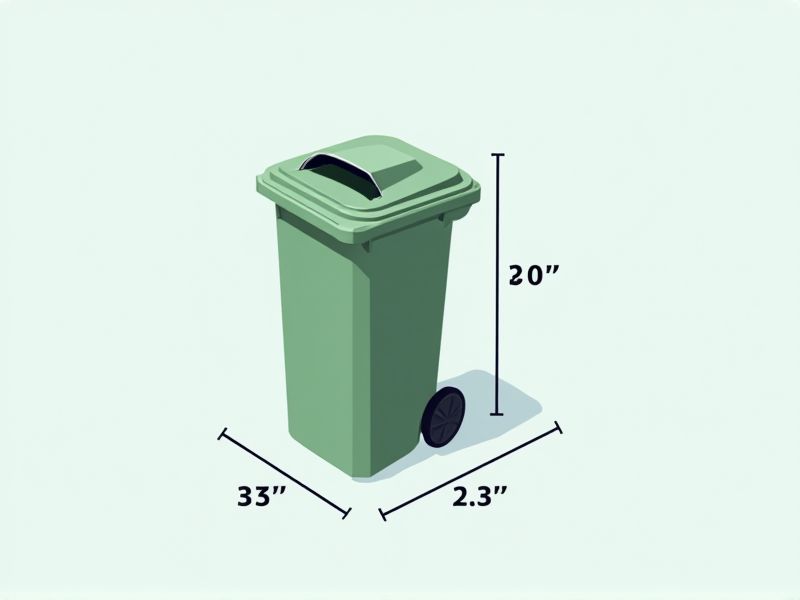
When selecting a trash can, it's helpful to know that standard kitchen trash cans typically range from 10 to 13 gallons, with dimensions averaging around 14-16 inches in width, 11-13 inches in depth, and 25-28 inches in height. Smaller trash cans, such as those for bathrooms or offices, commonly hold 2-4 gallons and measure about 9-11 inches wide and 11-14 inches tall. Knowing these standard dimensions helps ensure you choose a trash can that fits your space and garbage bag size. Before purchasing, it's always a good idea to measure your intended space and compare it to the product specifications for the best fit.
Volume Capacity
The optimal volume capacity for household trash cans typically ranges from 10 to 30 gallons, catering to various needs and household sizes. For smaller apartments, a 10 to 13-gallon trash can fits easily under sinks or in cabinets, whereas larger families may require 20 to 30 gallons for ample waste storage. When selecting a trash can, consider your waste disposal frequency; a more significant capacity reduces the need for constant emptying. Choosing the right size not only enhances convenience but also contributes to more effective waste management in your living space.
Height
When selecting a trash can, the height is a critical factor to consider for optimal usability and space efficiency. Standard heights typically range from 24 to 36 inches, making them suitable for both residential and commercial environments. A height of 30 inches is often ideal for easy access while maintaining a discreet profile that blends with your decor. Ensuring the right height not only enhances convenience but also promotes better waste management, making it easier for you to dispose of trash without bending or stretching awkwardly.
Width
When selecting a trash can, width is a crucial dimension to consider for optimal fitting in your space. Standard widths typically range from 12 to 30 inches, allowing options for compact areas or larger household needs. A wider trash can, generally exceeding 20 inches, accommodates more waste, reducing the frequency of disposal. Ensure your chosen width complements the flow of traffic in your kitchen or office, enhancing both accessibility and functionality.
Depth
When considering the optimal depth for a trash can, a measurement of 24 to 30 inches is commonly recommended for residential use, ensuring easy access for most individuals. This depth accommodates a typical capacity of 13 to 20 gallons, appropriate for daily household waste without frequent emptying. A deeper design can enhance waste segregation, allowing for the separation of recyclables and organic waste. You can maximize your waste management efficiency by selecting a trash can that aligns with these depth specifications.
Shape
The standard shapes for trash cans typically include round, square, and rectangular designs, each serving unique purposes in residential and commercial settings. Round trash cans are often preferred for easy mobility and aesthetic appeal, while square and rectangular options maximize storage space and fit neatly against walls or corners. Most trash cans range in capacity from 10 to 55 gallons, allowing you to select one that best suits your waste management needs. When considering shape, be sure to account for your available space and the specific types of waste you need to dispose of.
Lid Design
The design of trash can lids significantly impacts waste management efficiency, with approximately 70% of users favoring hands-free operation for improved hygiene and convenience. Opting for an airtight lid can reduce odors and discourage pests, enhancing cleanliness in public spaces. Many contemporary models feature a durable plastic or stainless steel construction, ensuring longevity and ease of maintenance. You can further enhance your waste disposal experience by selecting lids that integrate with waste sorting systems, promoting recycling and sustainability efforts.
Material
When selecting a trash can, consider the material for durability and sustainability. Stainless steel is a popular choice, offering resistance to rust and easy cleaning, while plastic options are lightweight and often more affordable. Higher-quality materials, such as recycled polypropylene or bamboo, promote eco-friendliness, reducing plastic waste. Your choice of material can significantly affect the lifespan of the trash can, with weather-resistant options lasting up to 10 years outdoors.
Weight Capacity
When selecting a trash can, consider a weight capacity ranging from 10 to 50 pounds, depending on your household's waste generation. A 30-gallon trash can typically holds about 20-30 pounds of materials, making it ideal for kitchens or high-traffic areas. You should also check if the trash can is constructed from durable materials, as this enhances its longevity and structural integrity. Lastly, remember that a well-chosen trash can not only accommodates your waste but also complements your home's aesthetic.
Color Options
When selecting a trash can, consider the variety of color options available, which can enhance your home decor or office aesthetics. Common colors include classic black, sleek white, vibrant red, and subtle pastel shades, allowing you to choose one that complements your space. Many manufacturers offer custom color choices, enabling a personalization aspect that aligns with your style preferences. Typically, a standard trash can size ranges from 10 to 50 liters, ensuring sufficient capacity while fitting seamlessly into your designated area.
Compatibility With Trash Bags
When selecting a trash can, consider its compatibility with standard trash bag sizes to enhance efficiency and convenience. Most residential trash cans typically align with 13-gallon bags, providing a perfect fit for everyday household waste. However, specific models may accommodate larger 32-gallon bags, ideal for yard debris or commercial use. Ensuring your trash can works seamlessly with appropriate bags can streamline waste management and minimize mess during disposal.
